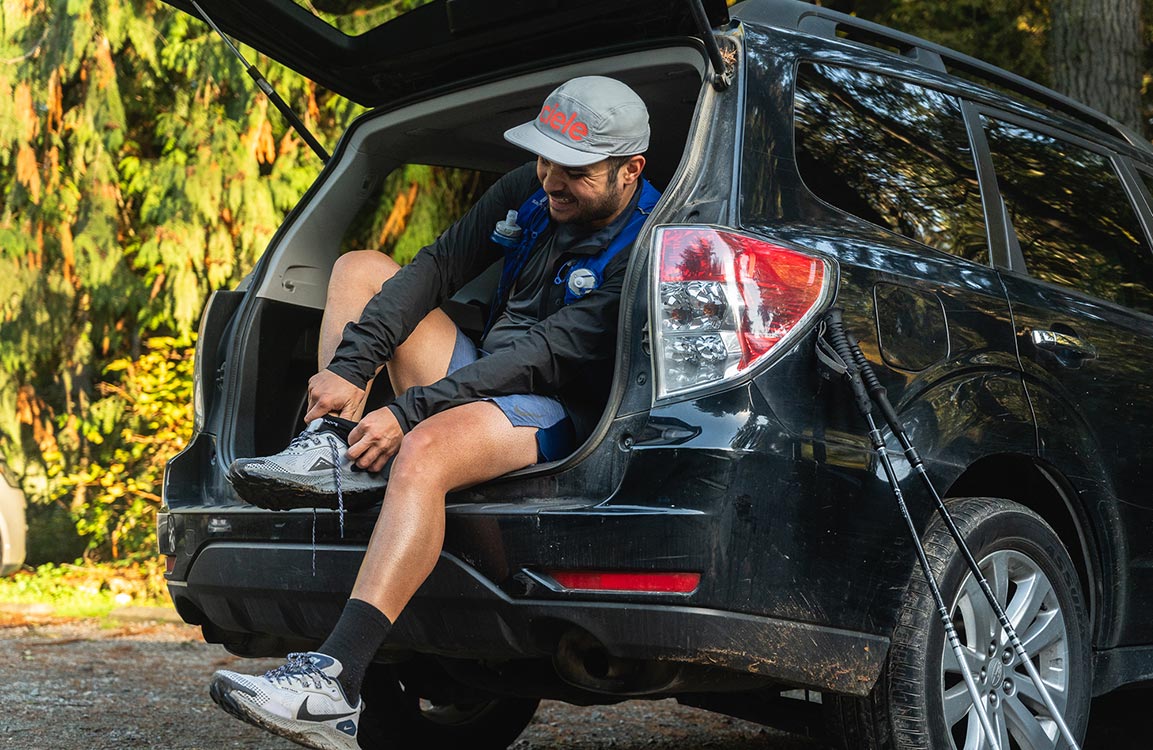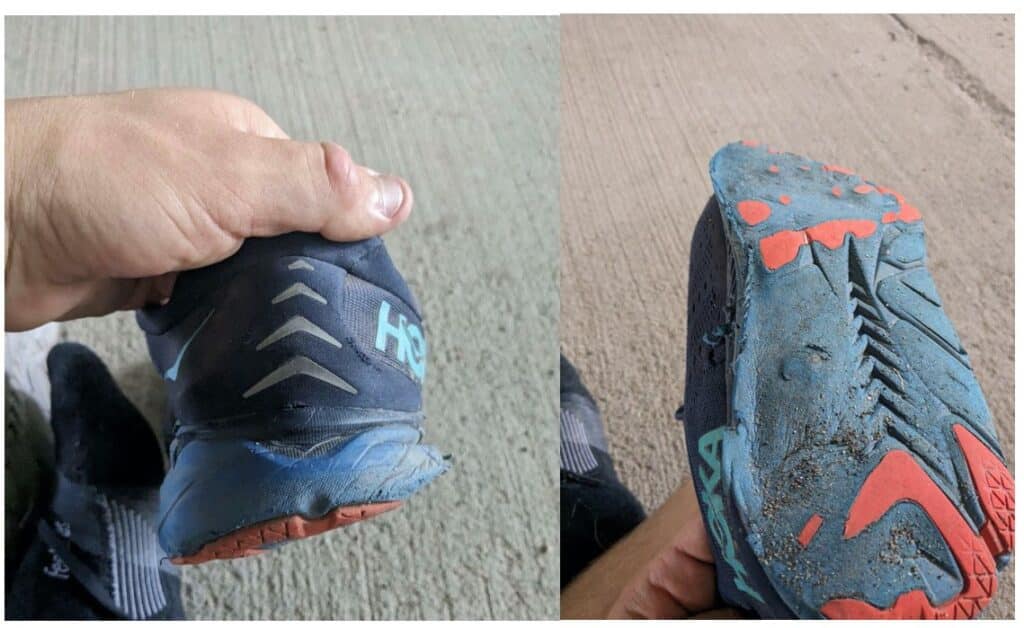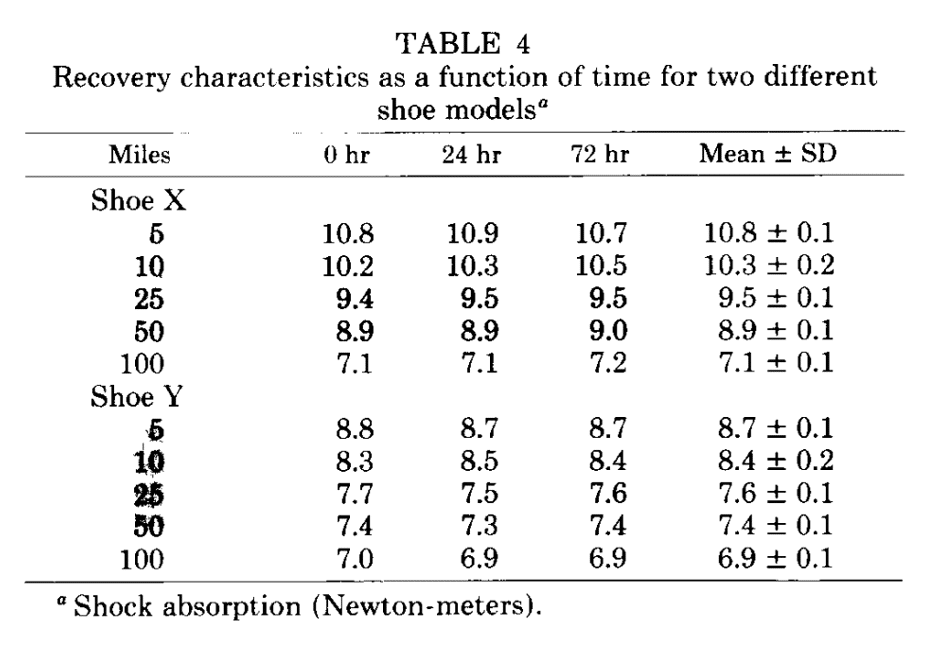
When to Replace Trail Running Shoes
By Ryne Anderson,
CTS Ultrarunning Coach
“All you need is a pair of shoes.” This phrase is often used to highlight the simplicity of running. Of course, once you add a hydration vest, GPS watch, apparel, poles, and race entry fees, the sport seems a lot less simple. At the center of it all, however, a good pair of shoes is a must. And although there’s no single shoe that’s perfect for all runners in all situations, all shoes wear out, so runners need to know how and when to replace them.
Life of a Running Shoe
The typical industry recommendations suggest replacing shoes anywhere between 300-500 miles. That’s a wide range. The optimal and safe lifespan of a shoe depends on the model, how you use the shoe, your gait, and how you care for the shoe.
Absorbing ground reaction force is a key factor that leads to wear and tear. Remember that your foot strikes the ground with a force roughly 2.5 times your body weight each time you land. The foam and materials in the shoe’s midsole compress and gradually lose their ability to cushion, support, and return energy. Your goal is to time the rotation or replacement of your shoes while they are performing as designed and providing the necessary support for each foot strike.
Traditionally, shoes with higher stack heights and more cushioning lasted for more miles compared to shoes with lower stack heights and less cushioning. This is still true for traditionally designed trail shoes and road shoes, because the thicker foam distributes impact through more material. In contrast, newer highly-cushioned, carbon plated midsole “super shoes” appear to wear faster, despite the thicker foam. However, these are more commonly used for road races rather than trail ultramarathons
The running surface and terrain also affect wear and tear. Terrain that leads to a more consistent foot strike (smooth trails and pavement) can cause the midsole and tread to degrade in a specific pattern. More varied terrain (technical trails with more climbing and descending) can spread the wear out more uniformly. Although this may help the sole wear more evenly or last longer, the variations in foot strike and stresses of conforming to technical terrain can cause the uppers to wear out faster.
Wear the right shoe for the job.
Don’t wear your trail shoes with the tacky outsole and large lugs on the pavement or track for an interval workout. Similarly, don’t wear your road shoes (or ‘’supershoes”) on rough singletrack. The differences between these shoe types are real and not just shoe company marketing language. The upper, midsole, and outsole of different shoes vary between models designed for specific conditions. Shoes intended for more technical terrain have more durable uppers and outsoles. Shoe intended for faster running may sacrifice durability, support, or protection (e.g. rock plates) to shave weight. Using shoes for their intended purposes may also spread wear and tear across multiple pairs, extending the time between required purchases.
Save your running shoes for running.
You don’t need your top-of-the-line trail running shoes to walk the dog or go for an easy hike with friends. It may seem extravagant or like splitting hairs, but using high-tech trail running shoes for daily activities just reduces the real running mileage you can accumulate with them. If you do use a trail shoe as your “daily driver”, be sure to account for that additional wear when scheduling the timing for replacement. A pair of shoes may only have 300 miles of running use, but daily use of the shoe could have it be more in line with 400 miles of wear.
Warning: Old running shoes may not be good walking shoes.
When you have decided to retire a pair of shoes, be mindful of how you use them in their next life. For example, I had an athlete who got an unexpected bout of IT Band syndrome. There had been no acute injury or unsustainable increase in his training volume or time at intensity. We were stumped on what was causing the issue. The athlete would walk his dog multiple times a day for an additional 3-6 miles a day. He was using his retired and worn-out running shoes for the daily dog walks. The foam had compressed significantly on the lateral aspect of the shoe (pictured below) to the point that each step caused excessive stress on his hip and knee, which led to the IT Band flare-up. To prevent future issues, this athlete got a dedicated pair of shoes to walk the dog. This is an extreme example but illustrates the point of how using a shoe beyond its life can contribute to injury.
Indicators to Replace the Shoe
For most runners, their foot strike creates a consistent wear pattern on a shoe. Some runners notice that the tread wears out more quickly on the heel, forefoot, medial, or lateral part of the shoe. Reference back to the above example for the perfect illustration of this point.
You should also pay attention to the upper of the shoe and note if the material is degrading faster in a specific area. Use these markers to help identify when the shoe is nearing the end of its life and needs replacement.
One of the most simple and effective ways to track the life of your shoes is to log the mileage for each pair. You can do this by hand or use technology. Strava, for instance, has a feature athletes can use to track the mileage for each of your shoes. It also has a feature that will alert you when you have reached 250 miles in a pair. Start paying closer attention to the wear of the shoe as it nears the 250- to 300-mile mark. Can you see any signs of degradation? Is the shoe starting to feel flat and like it has lost its cushion, rebound, or support? Also look at your subjective feedback from runs and workouts. Are those comments indicating that you’re feeling more sore or beat up after running in that pair of shoes? Does the shoe have less grip or traction? If you answer yes to any of these, it is time for a fresh pair.
Care for Shoes
Shoe care is an often-overlooked component in extending their lifespan. Shoes collect sweat, dirt, mud, and grit with each run. All these factors can act like sandpaper and wear out the upper quicker than planned from the friction of each foot strike.
Take the time to regularly hose your shoes off to remove excess grit and lessen the wear on the upper. Investing in a shoe dryer is a worthwhile purchase to expedite the process of drying out your shoes between runs. Don’t forget to give the laces a thorough rinse. More than once I’ve gone to lace up my shoes and the lace has snapped due to rot. Avoid leaving your shoes out on the porch to bake in the direct sun. This can also lead to the degradation of the shoe’s components.
Rotating Shoes
A common practice for many runners is to rotate between 2-3 pairs of shoes. Anecdotally, you hear many runners say they like to give a pair of shoes 24-48 hours between uses so the midsole can return to its original state. There is little supporting research to support the idea that extended rest periods are necessary for midsole decompression. One of the only studies in the area is from 1985 (Cook et al., 1985). Although the study showed shock absorption decreased with increased mileage, particularly between 250 and 500 miles, it also found the following regarding between-run recovery:
► Free Ultrarunning Training Assessment Quiz
Take our free 2-minute quiz to discover how effective your training is and get recommendations for how you can improve.
“The recovery characteristics of shoes tested and allowed to recover for periods of 24 and 48 hours are shown in Table 4. There was essentially no change in the values obtained by allowing the shoes to recover. The maximum differences observed were less than 3%, indicating that the shoes do not return back to the previously more shock absorbent condition. The amount of mileage accumulated on the shoe did not affect the recovery characteristics.”
A newer study from Malisoux et al. found that rotating through multiple pairs of shoes during the same period may decrease injury risk (Malisoux et al., 2013). The rationale for this could be that runners experience slower incremental changes in wear characteristics in each individual shoe.
Strategies for Shoe Rotation
Should you use the same brand and model your shoe rotation or have different models? For most, the shoe rotation will naturally have different models as you will wear specific shoes for different types of terrain. Rotating through various models has benefits, too, because your gait and stride will have slight changes from one model to the next. This can allow the muscles, tendons, and ligaments to be stressed in subtly different ways.
If you decide to have varying models in the rotation, be sure that each shoe has relatively similar specifications. Do not have one pair with a zero millimeter heel to toe drop and another pair with a 12 millimeter heel to toe drop. A shoe with a firmer midsole compared to a softer, more cushioned midsole will ride differently. Using shoes with noticeable differences in stack height, heel to toe drop, and midsole compound can lead to significant changes in biomechanics and footstrike that your gait may not be equipped to handle.
Raceday Shoes
You should spend significant time training in the shoe and on the terrain you plan to race on. I advise athletes to get a new pair of their favorite shoe (one they’ve been training in) 2-3 weeks before their race. Aim to accumulate around 50-75 miles in that new pair so you can ensure the shoe is broken in.
Enjoying This Article? Get More Free Running Training Tips
Get our coaches' best training advice, delivered straight to your inbox weekly.
‘Supershoes’ continue to grow in popularity. It is clear that super shoes can provide an advantage for road racing. The science does not entirely support the idea that super shoes are a worthwhile investment for trail and ultrarunners. Nevertheless, we know trail runners are trying them. Whether you throw on supershoes for a PR at a road race or to run 100 miles, it is imperative that you train in the shoe. The combination of the highly-reactive foam and carbon plate embedded in the midsole is meant, amongst a host of purported benefits, to provide more energy return and improve running economy. Not all runners respond well to these shoes, and not all runners experience an improvement in running economy, meaning not everyone goes faster. And for responders, it’s unclear whether there’s an improvement in running economy off-road. For a review of research on super shoes for trail and ultrarunning, see “Research Essentials for Ultrarunning, Issue 7.
Conclusion
Shoes are expensive. It can be tempting to try to squeeze out an extra 100 miles on a pair of shoes before buying new ones. A shoe is not meant to last forever. The midsole compounds and supportive nature of the upper degrade over time and using a shoe beyond its functional lifespan heightens the risk of injury.
As with every facet of training and racing, keep things simple. Find the shoe that is most comfortable for you and is equipped to handle the terrain you are running on. Track the mileage on your shoes and look for patterns related to how long each model you wear lasts. Be mindful of the wear and tear of the shoe and replace the shoe when it can no longer do its job.
References:
Cook, S D et al. “Shock absorption characteristics of running shoes.” The American journal of sports medicine vol. 13,4 (1985): 248-53. doi:10.1177/036354658501300406
Cornwall, Mark W, and Thomas G McPoil. “CAN RUNNERS PERCEIVE CHANGES IN HEEL CUSHIONING AS THE SHOE AGES WITH INCREASED MILEAGE?.” International journal of sports physical therapy vol. 12,4 (2017): 616-624.
Malisoux, L et al. “Can parallel use of different running shoes decrease running-related injury risk?.” Scandinavian journal of medicine & science in sports vol. 25,1 (2015): 110-5. doi:10.1111/sms.12154




Comments 4
Pingback: The Complete Ultramarathon Checklist: What to Pack for Race Day - CTS
Curious if running time changes how often to change shoes. Does running 50 miles in twelve hours create the same wear as running 50 miles in six hours?
Thank you Ryne! Very good.
Just as important to your training as a run training plan. I have been rotating through a variety of brands for 20 years and I’m sure that helped with less soreness , injuries etc. Now, the use of shoes for non-running after they are no good for running might be the reason for some heel pain I have had now and again. I’m sure glad I read the whole article.